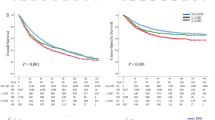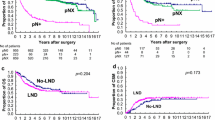Abstract
Purpose
To assess the risk factors of metastasis relapse in pT2-3 upper tract urothelial carcinomas (UTUCs) treated by radical nephroureterectomy (RNU) without lymphadenectomy (LN).
Methods
A multicentric retrospective study was performed for pT2-3 pNx UTUCs treated by RNU between 1995 and 2010. The following criteria were retrieved: age, gender, American Society of Anaesthesiologists physical status, surgical approach, preoperative hydronephrosis, stage, grade, tumor location, surgical margin, lymphovascular invasion (LVI) status and outcomes. Metastasis-free survival (MFS) was measured by Kaplan–Meier method with the log-rank test.
Results
Overall, 151 patients were included. The median follow-up was 18.5 months (IQR 9.5–37.9). The 2- and 5-year MFS were 69 % ± 4.5 and 54.1 % ± 5.8, respectively. In univariate analysis, ureteral location, pT3 stage, positive LVI status and positive surgical margin were significantly associated with worse MFS (p = 0.03; 0.02; 0.01 and 0.006, respectively). In the multivariate analysis of ureteral location and pT3 stage were independent prognostic factors (p = 0.03 and 0.03, respectively). Based on the results of the univariate analysis, we proposed a risk model predicting MFS, which classifies patients into 3 categories with different overall survival (p < 0.001).
Conclusion
In view of our data, tumor location, T stage, LVI and surgical margin status are mandatory to predict survival in case of RN without LN. Contingent upon external validation, our risk model based on these variables could be useful to provide relevant information concerning metastasis relapse probability and necessity of close follow-up for these patients.


Similar content being viewed by others
References
Colin P, Koenig P, Ouzzane A, Berthon N, Villers A, Biserte J et al (2009) Environmental factors involved in carcinogenesis of urothelial cell carcinomas of the upper urinary tract. BJU Int 104:1436–1440
Roupret M, Babjuk M, Comperat E, Zigeuner R, Sylvester R, Burger M et al (2013) European guidelines on upper urinary tract urothelial carcinomas: 2013 update. Eur Urol 63:1059–1071
Ouzzane A, Colin P, Ghoneim TP, Zerbib M, De La Taille A, Audenet F et al (2013) The impact of lymph node status and features on oncological outcomes in urothelial carcinoma of the upper urinary tract (UTUC) treated by nephroureterectomy. World J Urol 31:189–197
Roupret M, Hupertan V, Seisen T, Colin P, Xylinas E, Yates DR et al (2013) Prediction of cancer-specific survival after radical nephroureterectomy for upper tract urothelial carcinoma: development of an optimized post-operative nomogram using decision curve analysis. J Urol 189:1662–1669
Mason RJ, Kassouf W, Bell DG, Lacombe L, Kapoor A, Jacobsen N et al (2012) The contemporary role of lymph node dissection during nephroureterectomy in the management of upper urinary tract urothelial carcinoma: the Canadian experience. Urology 79:840–845
Roscigno M, Shariat SF, Freschi M, Margulis V, Karakiewizc P, Suardi N et al (2009) Assessment of the minimum number of lymph nodes needed to detect lymph node invasion at radical nephroureterectomy in patients with upper tract urothelial cancer. Urology 74:1070–1074
Abe T, Shinohara N, Muranaka M, Sazawa A, Maruyama S, Osawa T et al (2010) Role of lymph node dissection in the treatment of urothelial carcinoma of the upper urinary tract: multi-institutional relapse analysis and immunohistochemical re-evaluation of negative lymph nodes. Eur J Surg Oncol 36:1085–1091
Ariane MM, Colin P, Ouzzane A, Pignot G, Audouin M, Cornu JN et al (2011) Assessment of oncologic control obtained after open versus laparoscopic nephroureterectomy for upper urinary tract urothelial carcinomas (UUT-UCs): results from a large French multicenter collaborative study. Ann Surg Oncol 19:301–308
Sobin L, Godspodarowicz M, Wittekind C (2009) Renal pelvis and ureter: TNM classification of malignant tumours. Urological tumours. International Union against Cancer. Wiley-Blackwell, New York, pp 258–261
Mostofi FK, Sorbin LH and Torloni H (1973) International histological classification of tumours: histological typing of urinary bladder tumours, World Health Organization, New York
Novara G, Matsumoto K, Kassouf W, Walton TJ, Fritsche HM, Bastian PJ et al (2009) Prognostic role of lymphovascular invasion in patients with urothelial carcinoma of the upper urinary tract: an international validation study. Eur Urol 57:1064–1071
Kikuchi E, Margulis V, Karakiewicz PI, Roscigno M, Mikami S, Lotan Y et al (2009) Lymphovascular invasion predicts clinical outcomes in patients with node-negative upper tract urothelial carcinoma. J Clin Oncol 27:612–618
Colin P, Ouzzane A, Yates DR, Audenet F, Pignot G, Arvin-Berod A et al (2012) Influence of positive surgical margin status after radical nephroureterectomy on upper urinary tract urothelial carcinoma survival. Ann Surg Oncol 19:3613–3620
Ouzzane A, Colin P, Xylinas E, Pignot G, Ariane MM, Saint F et al (2011) Ureteral and multifocal tumours have worse prognosis than renal pelvic tumours in urothelial carcinoma of the upper urinary tract treated by nephroureterectomy. Eur Urol 60:1258–1265
Raman JD, Ng CK, Scherr DS, Margulis V, Lotan Y, Bensalah K et al (2009) Impact of tumor location on prognosis for patients with upper tract urothelial carcinoma managed by radical nephroureterectomy. Eur Urol 57:1072–1079
Isbarn H, Jeldres C, Shariat SF, Liberman D, Sun M, Lughezzani G et al (2009) Location of the primary tumor is not an independent predictor of cancer specific mortality in patients with upper urinary tract urothelial carcinoma. J Urol 182:2177–2181
Chromecki TF, Cha EK, Fajkovic H, Margulis V, Novara G, Scherr DS et al (2011) The Impact of tumor multifocality on outcomes in patients treated with radical nephroureterectomy. Eur Urol 61:245–253
Yafi FA, Novara G, Shariat SF, Gupta A, Matsumoto K, Walton TJ et al (2011) Impact of tumour location versus multifocality in patients with upper tract urothelial carcinoma treated with nephroureterectomy and bladder cuff excision: a homogeneous series without perioperative chemotherapy. BJU Int 110:E7–E13
Hall MC, Womack S, Sagalowsky AI, Carmody T, Erickstad MD, Roehrborn CG (1998) Prognostic factors, recurrence, and survival in transitional cell carcinoma of the upper urinary tract: a 30-year experience in 252 patients. Urology 52:594–601
Xylinas E, Rink M, Margulis V, Faison T, Comploj E, Novara G et al (2013) Prediction of true nodal status in patients with pathological lymph node negative upper tract urothelial carcinoma at radical nephroureterectomy. J Urol 189:468–473
Birtle AJ, Lewis R, Johnson M, Hall E (2012) Time to define an international standard of postoperative care for resected upper urinary tract transitional cell carcinoma (TCC)—opening of the peri-operative chemotherapy versus surveillance in upper tract urothelial cancer (POUT) trial. BJU Int 110:919–921
Rajput MZ, Kamat AM, Clavell-Hernandez J, Siefker-Radtke AO, Grossman HB, Dinney CP (2011) Perioperative outcomes of laparoscopic radical nephroureterectomy and regional lymphadenectomy in patients with upper urinary tract urothelial carcinoma after neoadjuvant chemotherapy. Urology 78:61–67
Youssef RF, Shariat SF, Lotan Y, Wood CG, Sagalowsky AI, Zigeuner R et al (2011) Upper urinary tract urothelial carcinoma with loco-regional nodal metastases: insights from the Upper Tract Urothelial Carcinoma Collaboration. BJU Int 108:1286–1291
Conflict of interest
The authors declare that they have no conflict of interest.
Author information
Authors and Affiliations
Corresponding authors
Additional information
The study was conducted for the French Collaborative National Database of UTUC.
Rights and permissions
About this article
Cite this article
Colin, P., Ghoneim, T.P., Nison, L. et al. Risk stratification of metastatic recurrence in invasive upper urinary tract carcinoma after radical nephroureterectomy without lymphadenectomy. World J Urol 32, 507–512 (2014). https://doi.org/10.1007/s00345-013-1116-1
Received:
Accepted:
Published:
Issue Date:
DOI: https://doi.org/10.1007/s00345-013-1116-1




